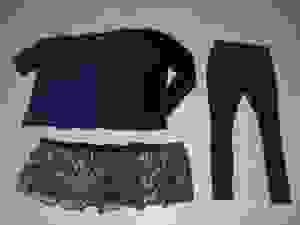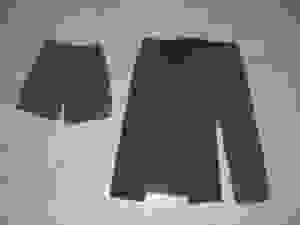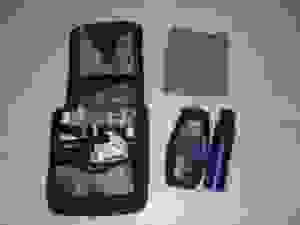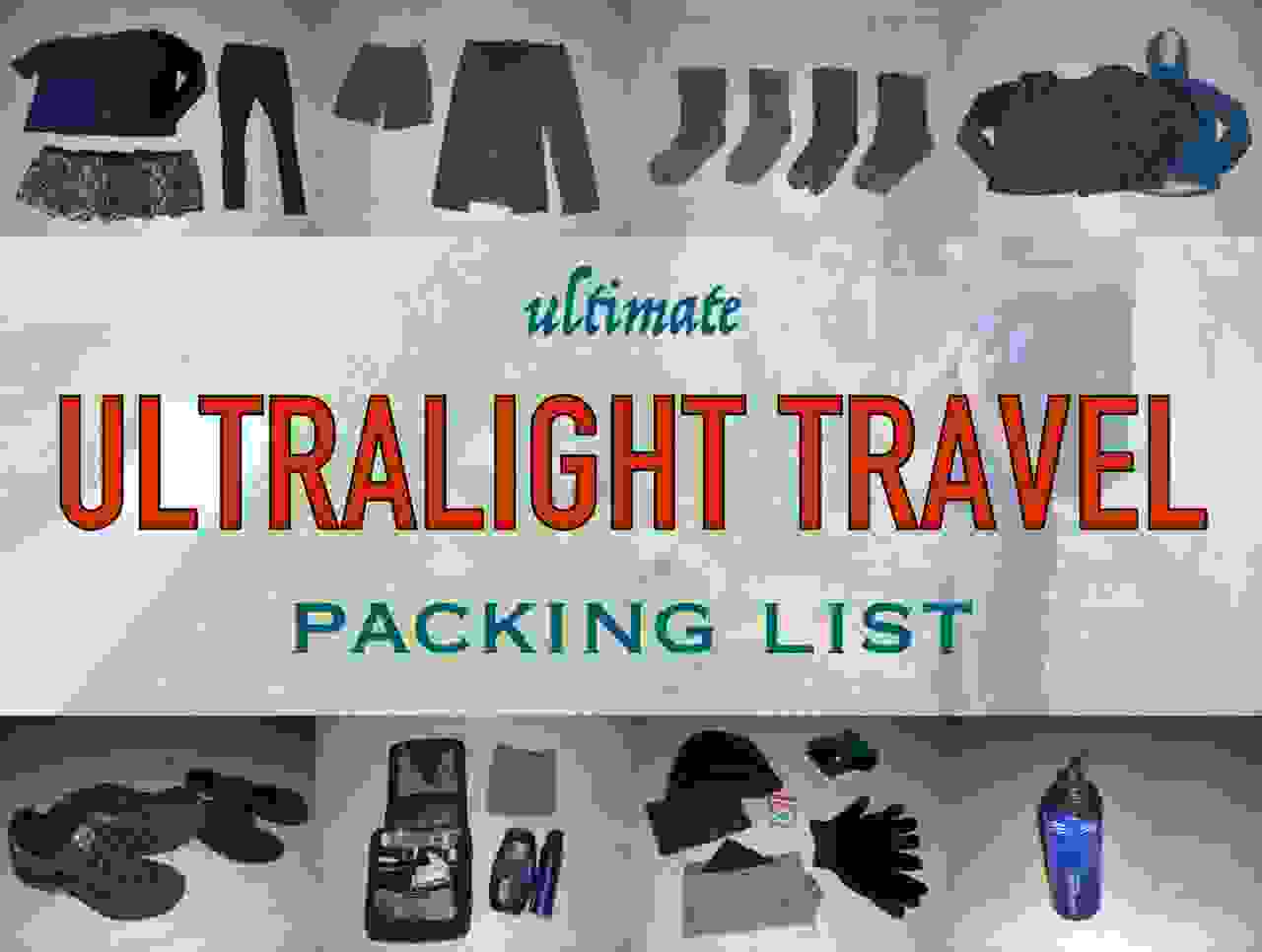Quite a few times I’ve heard backpackers complain about weight limits or maximum bag allowances on airlines. They haul 40-pound monstrosities that limit how comfortable they are, how fast they can run to catch the train, and how often they have to take a taxi because their bag is too heavy. They end up going a little slower, seeing a little less, and paying a little more. When they look at mine, they ask me where my “real” bag is.

I have traveled around the world on extended trips up to 9 months long with nothing but a 20 liter daypack, through summers, winters, jungles, cities, and everywhere else. It weighs less than fifteen pounds and fits in the overhead compartment on the plane.
I never have to worry about lost bags, check-in times, or waiting by the conveyor belt. I am the first person in line for customs, and stroll right in. I spend nothing on laundry or taxis. I am the first to finish packing every morning. I never spend more than five seconds trying to find something at the bottom of the bag. I wander around for hours with my pack, just because I can. I’ve gotten to the point that I really don’t know how to do it any other way, and my scrawny shoulders continue to thank me.
It’s a fun game I like to play with myself find to be an amusing intellectual challenge, but despite year after year of life on the road, I have met less than half a dozen people who do the same thing, and we are endlessly perplexed. Sadly, I have never been able to convince anyone to follow this plan. But I’ll give it one last try. It’s for your own good.
How to pack for ultralight travel

When thinking of things to pack for a trip, most people bring everything, “just in case,” and end up hauling a bag full of garbage they never use. Don’t do that.
Not a single person I’ve ever met has said “I wish I brought more.” You can spot the seasoned travelers simply by bag size. Instead of thinking about what to add, think about what you can cut. You know who else said that? Oh, just Bruce Lee is all.
Your limit should be the same as the airlines: 22” x 14” by 9”, or 45 liters (though it’s slightly smaller on certain no-frills European airlines). This will keep you in check (and allow you to reap the benefits of carry-on-only travel), since it’s all you can take, and it’s more than you need. If I got by with 20, you’ll get by with 45. Trust me. Just peruse this page and assume you’ll include twice as much.
1) Shopping for Ultralight Backpacks
For quite some time, the only options available were hiking packs, and while they’re quite good at what they do, a few companies have started designing what I consider travel-worthy backpacks (carry-on size, with a fully opening zippered panel, so you can pack it like a suitcase), which work great when you want to open everything up, instead of traditional top-loaders that need to be emptied completely to find something down at the bottom.
Since travel often requires lots of packing and unpacking, and somewhat less walking, it generally makes more sense to get a backpack optimized for travel, rather than hiking (unless you plan on hiking with it, of course). Check out a list of favorites here.
Wheeled suitcases aren’t a terrible idea, especially if you have back problems, but just remember they add weight and you’ll go crazy on cobblestones.
2) Ultralight Travel Clothing Basics
People constantly ask “how can you have enough in a daypack to travel for a year?” The thing is, you’re not packing for a year. No one is.
The secret is to pack the same gear, no matter how long the trip is. I bring 3 sets of clothes, wash whatever outfit I’m wearing when I take a shower, and hang it up to dry overnight. And you don’t even need to do manual laundry. If you bring a week’s worth of clothing and do laundry once a week, you can travel forever. It’s that simple.
You might get stuck with a sink wash sooner or later, which is why everything should (hopefully) be high-performance and versatile, wicking sweat and drying quickly, which cools you in summer, and warms you in winter. Try not to bring separate clothes for hiking, lounging, and clubbing. Just get clothes that look good and feel good. They should be suitable for any social situation. It’s a tall order, but it can be done.

Shirts: No cotton. It soaks up sweat and stays wet all day. Get polyester or merino wool t-shirts (read more about why merino is everyone’s favorite here), both of which wick sweat and dry quickly. Polyester should have an odor-control treatment if you plan on making any friends. Though I won’t judge you, it’s nice to have a fancy shirt for special occasions. I’d skip warmer thermal underwear. You can only wear them in winter, and you’ll probably bring t-shirts anyway, which dry faster after a sink wash. Leave the insulation to the outer layers, which you don’t need to wash as often.
Underwear: Let me tell you, “performance underwear” feels just as good as it sounds. Spoil yourself. Again, make sure it’s quick-drying, lightweight, odor-resistant, and comfy (take a look at a list of favorites here). In winter, long underwear works wonders. You’ll only need a single pair if you wear regular underwear underneath, so you won’t have to wash the heavier one as often.

Pants and shorts: Travel pants, ideally, should be lightweight, wrinkle-free, water-resistant, quick-drying, and look completely normal, despite having a few hidden pockets for hiding valuables. There are literally only a few that actually do this (which is ridiculous), but you can find a list of good travel pants here. Try to find pants that don’t look too silly, so you won’t have to bring extra pants for fancy fun times. If your pants fit, you can skip the belt, and for guys, quick-dry shorts double as swimwear. You can cut some corners here, as cotton pants won’t hold you back so much if you have an umbrella, don’t mind washing rarely, or have laundry facilities. Given the rarity of truly travel-worthy jeans, don’t feel bad bringing regular jeans.

Socks: I bought a pair of merino wool socks and threw out all my white cotton gym socks the same day. Seriously. Merino wool warms in winter, cools in summer, insulates even when damp, dries quickly, resists odor, and is soft and plush and wonderful. I’ve found nothing more comfortable for my feet. Most socks blend merino with polyester and other materials, and work well. I bring two ultralight pairs for summer use, and a warmer pair in winter, worn over the lighter ones so I don’t have to wash the heavy ones as often.
3) Outer layers
Layering is crucial. It’s better to take a few lighter pieces that you can layer together, rather than a heavy one you can only wear in Antarctica. You may have your own comfort system on this, but here’s what I recommend (or check out my winter travel gear list for details):

Inner warm layer: Find the lightest fleece or wool sweater you can find, comfortable when it’s cool, but not cold. I look for close fits to layer more easily, and a high, snug neck so I can skip the scarf.
Outer warm layer: For winter travel, goose down or synthetic insulation jackets (those big puffy ones) are one of the best ways you can shrink things down. Goose down is triple the warmth of fleece for the same weight, and packs down to half the size, meaning a medium-warmth jacket weighs 8 ounces. Synthetic insulation isn’t as warm or packable, but it dries faster and retains its insulating qualities when wet, whereas goose down does not, which is why I have thus far gone with synthetic. Since it is encased in a nylon shell, it works well as a windproof outer layer, while the fleece sweater on the inside will be comfortable against your skin.
Rain jackets: I don’t have much to say here, and umbrellas work well enough anyway. I just look for light weight, comfort, a hood that covers my face, and enough venting to keep me cool (take a look at some ultralight rain shells, some of which are half the weight of standard jackets). Don’t get something insulated that you can only wear in winter. Layer instead.
Wind jackets: Climbing up a windy mountain on a chilly day calls for something windproof that won’t overheat, and a wind shell is the only thing that fits the bill. I wouldn’t call it a necessity, but mine is about 3 ounces, and I wear it all the time.
4) Travel Shoes
I met a guy with separate hiking boots, running shoes, evening shoes, and sandals. Here’s an idea. Why not buy shoes that look good and feel good?

There’s not much reason to bring serious hiking boots, which are designed to support 50-pound packs, which you won’t have. A nice-looking, tough, comfortable shoe that fits properly and offers good support will be suitable for all occasions. Especially if they’re waterproof.
One pair of shoes, end of story (probably leather, described here). And one pair of flip-flops or sandals. Comfy but light.
Women’s fashion is less forgiving. If you have to bring a separate pair of evening shoes, just make them small. If all it’s got on top are straps that can lay flat, perfect. Only bring one pair. Anyone who calls you out on repeat clothing will be another scruffy backpacker who will be in no place to make comments.
5) Travel Accessories
Again, anything you stuff in here should add value, not just weight. So far I’ve avoided packing cubes, but they’re not a bad idea.

Toiletries: I travel with nothing but airplane-sized bottles (maximum 3.3 ounces, or 100 mL) so I can take them on the plane, and reuse them on each trip. When the bottles run out I buy a larger one, refilling the mini so I can throw the big one away sooner. This way I might have one or two big bottles at any one time, instead of my entire supply being oversized (though an all-in-one bar soap is great for solving this problem). Check out a comprehensive toiletries list for details.
Travel towel: This is another of the most significant ways you can cut size and weight, as huge cotton towels are big, heavy and dry slowly. Microfiber towels are light, small, super absorbent, and wring out 90% dry. You can even get by with a washcloth-sized micro towel which will fold up to the size of a napkin, though it’ll take some extra time to dry yourself off. Definitely get one of these. They’re cheap and enormously efficient (though I’ve recently discovered linen towels are even better).

Sleeping bags: This is another one of those “surely I must need this” items that people end up never using. 99% of people stay in hostels and never use their sleeping bag. If you’re worried about hostels that require you to rent sheets, I’ve traveled for 15 months and spent maybe $3 on them. It’s not worth the extra weight. If you want to be a little warmer, you can sleep in your long underwear, or you can get a bag liner, which is incredibly lightweight and small, and will keep you warm enough indoors. If you really need a sleeping bag, you can find some that are the size of a 1 liter water bottle and weigh 1 pound. But if you don’t plan on camping, forget it.
Daypack: I try to avoid bringing an extra bag, but now that we have ultralight options that fold up into their own pocket, I’d recommend it. You’ll do a daytrip or climb a mountain and you’ll want to bring a jacket, food, water, maps and whatever. I had one made by Sea to Summit that holds 20 liters, weighs 2.4 ounces, and fits inside a coffee mug.

Other extras: I’d recommend a money belt (unless your pants have security pockets), a deck of cards, a nice small camera (or smartphone), a journal, sunglasses, an outlet converter, hat, gloves, and two books (it’s hard to find a book right away once you finish), or an e-reader. Those are all the extras I ever use. Umbrellas aren’t a bad idea if you don’t want to spend $100 on a rain jacket. Just remember that if you want to add extras, think about how often you’ll use it, and if it’ll be worth it.
Budgeting for ultralight travel

Poor? So was I. Patrol eBay and watch for sales. Besides, you shouldn’t buy more than a minimum of gear. Three backpacking outfits shouldn’t be too expensive, and you might have a few running shirts already, and some warm clothes, and good shoes. Some of it you’ll wear back at home after the trip, especially the socks and underwear.
If you have to cut corners when packing for a trip, regular cotton pants and shorts will be fine, as long as you’re not washing too often and rainstorms don’t ruin your day. You can skip the rain jacket and bring an umbrella, and winter gear can be cut outside of winter. I wouldn’t cut the travel towel, since it’s less than $20 and will save you lots of space and weight, and quick-drying base layers are kind of a necessity for this to work, unless you’re doing machine washes once a week or so, in which case it’ll be fine.

You should now be a thoroughly converted ultralight, minimalist backpacking genius. Once you do this, it’s hard to go back. This method is forced upon all travelers on Rick Steves’ tours, many of whom claim it’s impossible ahead of time, but talk about how great it is after. This strategy has close to a 100% success rate. And whether you’re packing for Europe, or Asia, or India, summer or winter, it’s always the same.
Oh, and by the way, the photos displayed here represent absolutely everything I took on a 9 month trip (except the camera), from temperatures below freezing to body-temperature sunshine. Towards the end of the trip, someone asked if there was anything I would have added. I said no. Someone else asked if there was anything I would have removed. I said no. I was super proud of myself.
Eventually I added a few things: A packable daypack, an ultralight wind jacket, a collared shirt, and swapped the emergency blanket for a sleeping bag liner instead (which is still just optional anyway). Overall weight was almost the same, and these items can be extremely useful.
Hmm. Talking about all this makes me want to go shopping. I’ve been working on getting my year-round pack down to about 12 pounds…





Thanks for this useful list, I’ve been thinking about how to get around with only one check-in pack and somehow manage to look decent at a wedding I’m attending at the end of my trip!
My plan is to get a dress/skirt I can crush into a small spot (likely cotton, with patterns to detract from the fact the dress will not be ironed, ever.) which will replace a pants/shirt set. I’ll get black thermal underwear I can wear under the dress for the NY winter & I can just wear the dress for the summer wedding in The Bahamas. I have small flat red leather shoes which can be packed flat (ugh, but to bring close-toe shoes and thongs/flip-flops…) and figured I could fit in a lipstick and mascara, and just wear ultra light “nice” jewellery.
Anyone done anything similar?
Regards and thanks for the list! It’s really helped my planning.
cheers!
I’ve seen certain outdoor companies like Patagonia make travel dresses that do their best to avoid wrinkles. That’s about as far as I can go with female fashion advice, but there might be some decent options out there somewhere if you don’t have something that’ll work already.
Old comment, but an old trick for wrinkles is to hang the item of clothing in a bathroom while you’re showering, or inside a stall if you can keep it dry. The combination of steam and gravity takes the wrinkles out and lets you get away with a wider variety of styles. I’ve used it for dress shirts, should work fine with dresses.
I’m due to go travelling in Malaysia in a few days time and this article has been very inspiring!
Thanks for the tips, they will be very useful on a 40-day trip I’m about to start. =)
Do you use anything to make your trip more comfortable? I’m especially looking for neck pillows, but other ideas will also be nice. I’ll be travelling a lot by bus, and some parts of my trip will take like 8-12 hours and be my night of sleep.
(going from Canada to USA and then Mexico, all by bus, then coming back by plane)
I hate bus travel with a fiery passion. It is my arch nemesis. That said, certain bus companies include chairs that can be reclined nearly to a horizontal position, which helps out quite a bit. If you can’t find one of those, then a neck pillow (try to find a self-inflating one) and maybe an eye mask would be helpful, but for the most part, you’ll just have to grit your teeth and bear the unbearable.
I have a Merrell jacket that turns into a neck pillow (folds into a zipped compartment). It is also reversible (dark brown on one side and light brown herringbone pattern on the other, so two jackets in one). When turned into a U shaped neck pillow, the outside is all a soft flocked material, which when turned back into a jacket is hidden inside and doesn’t show either side. I’m not sure if they still make these, but I don’t know why they would stop. It is an invaluable part of my travel.
Hello there. First, I wanted to thank you very much for your website. All your hard work has really helped me out in my own travel planning. If you please, I wonder if you might tell me the brand of the fleece sweater in the above “outer layer” section? It’s a really nice looking one. Thank you very much and have a pleasant summer.
It is a Helly Hansen, called the Prostretch Jacket, as I recall. I got it all the way back in 2005, and it’s still here in the closet, and still finds a place in the regular rotation even after all this time. But its age is showing…I’ve been trying to find something to replace it for a long time, but for whatever reason, nobody seems to use super stylish steely blue. Morons!
The ultimate packing list is the clothes on your back, money, credit card, passport, folding toothbrush. Anything else buy when you need it.
I’ve just bought myself the Osprey Farpoint 40 with the plan to travel with as little as possible and feel like I have followed your list closely and I can’t get close to fitting everything in. My only problem is I am taking walking boots as I am trekking for days through the amazon and doing the Inca trail as part of my trip. At the moment my bag is packed tight and it has no fleece, no packable daypack and no toiletries, so a lot missing. What am I doing wrong?
Hmm…sheer quantity of clothing maybe? Books? Large rain jacket? Hard to say without being able to see it, though…it’s possible to find high-quality walking shoes that can double as regular shoes (though it’s good to have sandals in addition to that, especially since it’ll be pretty hot in a lot of places). I would recommend finding the biggest things, and seeing if you can find smaller alternatives, and seeing if you could also decrease the overall number of items, particularly clothing. Also, rolling your clothes is generally a little better than folding (though generally I leave collared shirts packed flat).
A great post to foster the gospel of travel freedom! May I add that all the advantages of travelling light are multiplied when you are older. When I retired after working for 40 years my goal was to travel with 40% of the maximum allowable carry-on. After a little tweaking, I now take beween 25-30% of the allowable carry-on for any trip (usually 49L for first bag and 21L for personal item). I found that a 19L bag was even sufficient for a January-February trip through Canada (thank you, my iPod Touch {instead of a computer} and merino wool!). If it fits under the seat in front of you, you don’t even have to fight with those stuffing shamefully oversized bags into the overhead bin and hogging all the space. Being 60 years old and jumping off the plane with my one little bag and striding to the exits to catch the bus while others wait at the luggage carousel for their behemoths still is a thrill! Keep spreading the word!
I just saw a 60 year old guy with what I’m pretty sure was a 90 liter pack. I just don’t know how they do it. How can they not want a lighter load? But oh well. Generally I find the best way to convince people is just by walking around with my pack while they’re walking around with theirs.
I was browsing at backpacks once again, and saw Deuter Futura 20 SL. Got any comments on that? I think you had a Deuter before right?
It’s either that… or Tom Bihn Synapse 19 or Gregory J23.
Deuter drives me completely insane. Definitely go into a store and try them out. They shove pressure points into me from all sorts of directions, and feel like they’re falling backward. Other people seem to like them, but the Gregory J series (or the Z series, which is the men’s version) are vastly more comfortable for me. Your own experiences may be different, but I definitely recommend taking a look at Gregory too. If you don’t sweat much, the Synapse is great, and very much resembles a “regular” bag.
Interesting. I had the opposite experience. I went from an osprey Sirrus 24 to the Deuter ACT trail 22 SL because the Osprey kept leaning me backward, the Deuter felt so much more centered. Although neither had pressure point issues. I guess different body types maybe. I’m female btw.
I’ve recently become a fan of the website and it helped immensely in planning for our annual European vaction. I’m not a backpacker, but watching my kids travel with relatively small packs convinced me, along with Snarky and onebag.com, to give it a try. While not a dedicated backpacker list, it worled for this middle aged guy.
For our recent 17 day trip, I had the following:
ebags Motherlode Weekender Convertible – carry on compatible which helped since we had 3 flights once in Europe and it fit on planes flown by Adria, Easyjet, and Intersky:
2 pair Royal Robbins Global Traveler Stretch Pant – fairly quick dry, good fit; I think they look normal enough, but can understand if others are a little put off. I had ordered some Rohans, but they didn’t fit and I ran out of time;
3 pair shorts – 2 North Face and 1 off brand from SteinMart- I need pockets for reading glasses, cash, phone, wifi hotspot, etc and these all did the trick;
2 pair Darn Tough merino wool socks. Nice and they dry pretty damn quickly;
3 polo shirts- all poly flying the colors of my national champion UCONN Huskies and FSU Seminoles. I know they are the last thing most tourists want to sport in Europe and probably not in the backpacker hall of fame, but they dry quickly, wear well and I don’t really otherwise care :)
4 button down poly shirts – 2 from White Sierra (through Peter Glenn) and 2 I had on hand. They all washed fine;
2 undershirts/2 briefs from Uniqlo Airism. Great suggestion.
1 boxer – Ex Officio
2 pair Johnston Murphy slip ons. I hate the idea of wet shoes so I brought a second pair. Not a big fan of sandals.
1 Columbia rain jacket (from Ireland golf trip a few years back)
With toiletries this was a very manageable weight, even for a 58 year old somewhat out of shape leisure traveler. The washing of whatever is in need takes no more than a few minutes, either in the night or morning, and is not a bother. As long as my back holds out, this is the way to go moving forward. No more dragging huge cases with broken handles up metro stairways.
Thanks for a fun and informative site.
Always happy to help, and I’m glad all my dorky gear suggestions are actually useful somehow. I started minimizing as much as possible because I’m pretty small, but even stronger people can use a break. Carrying huge packs around all day isn’t much fun.
Great post.
I have been traveling for 4 months through Eastern Europe, Africa, and South America with Outlier pants and a Wool &Price LS collared shirt and I don’t feel like a dork out at night. I use a Tom Bihn Synapse 25 and, with what I carry, I have plenty of room to spare.
The only thing, I haven’t seen mentioned, that I carry and use on a daily basis is a tiny Bluetooth speaker like this one:
http://lonlittleshop.com/products/lon-little-speaker-bluetooth
As a matter of fact, I’m sitting on a balcony in Medellin, drinking coffee and listening to music right this minute.
Buen viaje!
I just came back from a trip with a Synapse 25, and it was great. I’ll be adding a packing list post sooner or later with all the details, but it’s pretty similar to this. Pretty sure I’ve read a few of your posts over on the TB forums, too…